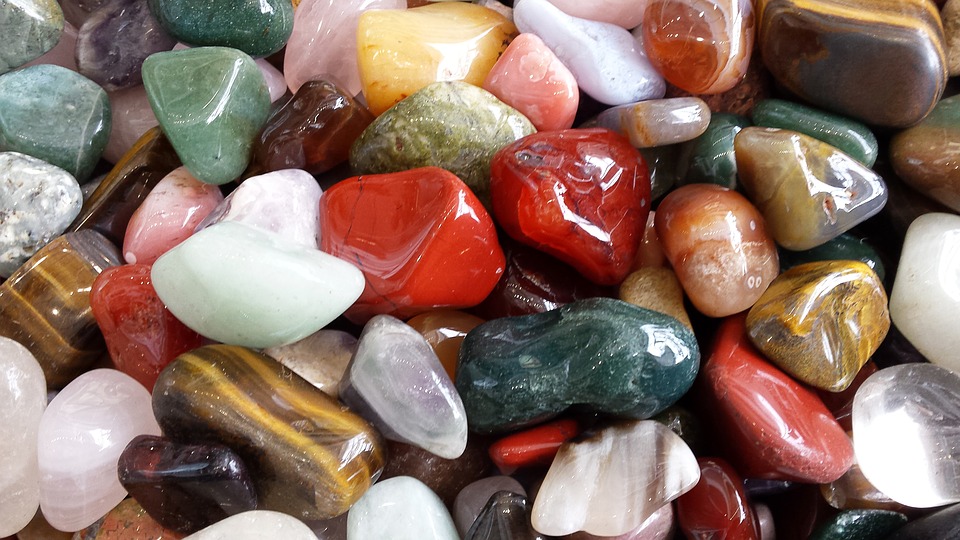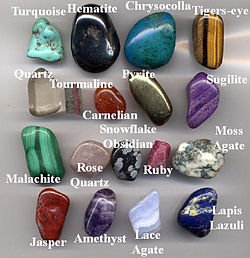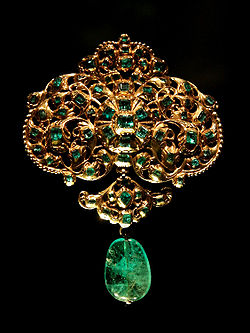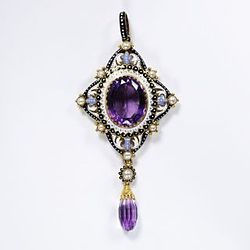THE BEAUTY IN PRECIOUS/GEM STONE

A gemstone (also called a gem, fine gem, jewel, precious stone, or semi-precious stone) is a piece of mineral crystal which, in cut and polished form, is used to make jewelry or other adornments.[1][2] However, certain rocks (such as lapis lazuli, opal, and jade) or organic materials that are not minerals (such as amber, jet, and pearl) are also used for jewelry and are therefore often considered to be gemstones as well. Most gemstones are hard, but some soft minerals are used in jewelry because of their luster or other physical properties that have aesthetic value. Rarity is another characteristic that lends value to a gemstone.
Apart from jewelry, from earliest antiquity engraved gems and hardstone carvings, such as cups, were major luxury art forms. A gem maker is called a lapidary or gemcutter; a diamond worker is a diamantaire. The carvings of Carl Fabergé are significant works in this tradition.
CHARATERISTICS

The traditional classification in the West, which goes back to the ancient Greeks, begins with a distinction between precious and semi-precious; similar distinctions are made in other cultures. In modern use the precious stones are diamond, ruby, sapphire, and emerald, with all other gemstones being semi-precious.[3] This distinction reflects the rarity of the respective stones in ancient times, as well as their quality: all are translucent with fine color in their purest forms, except for the colorless diamond, and very hard, with hardnesses of 8 to 10 on the Mohs scale. Other stones are classified by their color, translucency and hardness. The traditional distinction does not necessarily reflect modern values, for example, while garnets are relatively inexpensive, a green garnet called tsavorite can be far more valuable than a mid-quality emerald.[4] Another unscientific term for semi-precious gemstones used in art history and archaeology is hardstone. Use of the terms 'precious' and 'semi-precious' in a commercial context is, arguably, misleading in that it deceptively implies certain stones are intrinsically more valuable than others, which is not necessarily the case.
In modern times gemstones are identified by gemologists, who describe gems and their characteristics using technical terminology specific to the field of gemology. The first characteristic a gemologist uses to identify a gemstone is its chemical composition. For example, diamonds are made of carbon (C) and rubies of aluminium oxide (Al
2O
3). Next, many gems are crystals which are classified by their crystal system such as cubic or trigonal or monoclinic. Another term used is habit, the form the gem is usually found in. For example, diamonds, which have a cubic crystal system, are often found as octahedrons.
Gemstones are classified into different groups, species, and varieties.[5] For example, ruby is the red variety of the species corundum, while any other color of corundum is considered sapphire. Other examples are the emerald (green), aquamarine (blue), red beryl (red), goshenite (colorless), heliodor (yellow), and morganite (pink), which are all varieties of the mineral species beryl.
Gems are characterized in terms of refractive index, dispersion, specific gravity, hardness, cleavage, fracture, and luster. They may exhibit pleochroism or double refraction. They may have luminescence and a distinctive absorption spectrum.
Material or flaws within a stone may be present as inclusions.
Gemstones may also be classified in terms of their "water". This is a recognized grading of the gem's luster, transparency, or "brilliance".[6] Very transparent gems are considered "first water", while "second" or "third water" gems are those of a lesser transparency.[7]
VALUE




There is no universally accepted grading system for gemstones. Diamonds are graded using a system developed by the Gemological Institute of America (GIA) in the early 1950s. Historically, all gemstones were graded using the naked eye. The GIA system included a major innovation: the introduction of 10x magnification as the standard for grading clarity. Other gemstones are still graded using the naked eye (assuming 20/20 vision).[8]
A mnemonic device, the "four Cs" (color, cut, clarity, and carats), has been introduced to help the consumer understand the factors used to grade a diamond.[9] With modification, these categories can be useful in understanding the grading of all gemstones. The four criteria carry different weight depending upon whether they are applied to colored gemstones or to colorless diamonds. In diamonds, cut is the primary determinant of value, followed by clarity and color. Diamonds are meant to sparkle, to break down light into its constituent rainbow colors (dispersion), chop it up into bright little pieces (scintillation), and deliver it to the eye (brilliance). In its rough crystalline form, a diamond will do none of these things; it requires proper fashioning and this is called "cut". In gemstones that have color, including colored diamonds, it is the purity and beauty of that color that is the primary determinant of quality.
Physical characteristics that make a colored stone valuable are color, clarity to a lesser extent (emeralds will always have a number of inclusions), cut, unusual optical phenomena within the stone such as color zoning (the uneven distribution of coloring within a gem) and asteria (star effects). The Greeks, for example, greatly valued asteria gemstones, which were regarded as powerful love charms, and Helen of Troy was known to have worn star-corundum.[10]
Aside from the diamond, the ruby, sapphire, emerald, pearl (not, strictly speaking, a gemstone), and opal[11] have also been considered to be precious. Up to the discoveries of bulk amethyst in Brazil in the 19th century, amethyst was considered a precious stone as well, going back to ancient Greece. Even in the last century certain stones such as aquamarine, peridot and cat's eye (cymophane) have been popular and hence been regarded as precious.
Today such a distinction is no longer made by the gemstone trade.[12] Many gemstones are used in even the most expensive jewelry, depending on the brand name of the designer, fashion trends, market supply, treatments, etc. Nevertheless, diamonds, rubies, sapphires, and emeralds still have a reputation that exceeds those of other gemstones.[13]
Rare or unusual gemstones, generally meant to include those gemstones which occur so infrequently in gem quality that they are scarcely known except to connoisseurs, include andalusite, axinite, cassiterite, clinohumite and red beryl.[14]
Gem prices can fluctuate heavily (such as those of tanzanite over the years) or can be quite stable (such as those of diamonds). In general per carat prices of larger stones are higher than those of smaller stones, but popularity of certain sizes of stone can affect prices. Typically prices can range from US$1/carat for a normal amethyst to US$20,000–50,000 for a collector's three carat pigeon-blood almost "perfect" Ruby....
More update coming soon or u can read up at https://en.m.wikipedia.org/wiki/Gemstone
